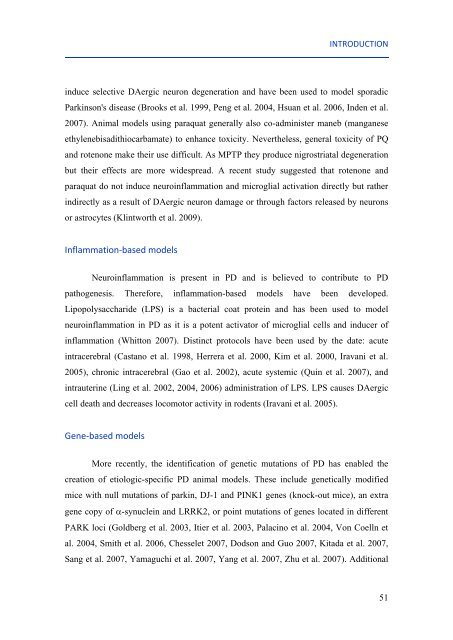Mechanisms of aluminium neurotoxicity in oxidative stress-induced ...
Mechanisms of aluminium neurotoxicity in oxidative stress-induced ...
Mechanisms of aluminium neurotoxicity in oxidative stress-induced ...
Create successful ePaper yourself
Turn your PDF publications into a flip-book with our unique Google optimized e-Paper software.
INTRODUCTION<br />
<strong>in</strong>duce selective DAergic neuron degeneration and have been used to model sporadic<br />
Park<strong>in</strong>son's disease (Brooks et al. 1999, Peng et al. 2004, Hsuan et al. 2006, Inden et al.<br />
2007). Animal models us<strong>in</strong>g paraquat generally also co-adm<strong>in</strong>ister maneb (manganese<br />
ethylenebisadithiocarbamate) to enhance toxicity. Nevertheless, general toxicity <strong>of</strong> PQ<br />
and rotenone make their use difficult. As MPTP they produce nigrostriatal degeneration<br />
but their effects are more widespread. A recent study suggested that rotenone and<br />
paraquat do not <strong>in</strong>duce neuro<strong>in</strong>flammation and microglial activation directly but rather<br />
<strong>in</strong>directly as a result <strong>of</strong> DAergic neuron damage or through factors released by neurons<br />
or astrocytes (Kl<strong>in</strong>tworth et al. 2009).<br />
Inflammation-based models<br />
Neuro<strong>in</strong>flammation is present <strong>in</strong> PD and is believed to contribute to PD<br />
pathogenesis. Therefore, <strong>in</strong>flammation-based models have been developed.<br />
Lipopolysaccharide (LPS) is a bacterial coat prote<strong>in</strong> and has been used to model<br />
neuro<strong>in</strong>flammation <strong>in</strong> PD as it is a potent activator <strong>of</strong> microglial cells and <strong>in</strong>ducer <strong>of</strong><br />
<strong>in</strong>flammation (Whitton 2007). Dist<strong>in</strong>ct protocols have been used by the date: acute<br />
<strong>in</strong>tracerebral (Castano et al. 1998, Herrera et al. 2000, Kim et al. 2000, Iravani et al.<br />
2005), chronic <strong>in</strong>tracerebral (Gao et al. 2002), acute systemic (Qu<strong>in</strong> et al. 2007), and<br />
<strong>in</strong>trauter<strong>in</strong>e (L<strong>in</strong>g et al. 2002, 2004, 2006) adm<strong>in</strong>istration <strong>of</strong> LPS. LPS causes DAergic<br />
cell death and decreases locomotor activity <strong>in</strong> rodents (Iravani et al. 2005).<br />
Gene-based models<br />
More recently, the identification <strong>of</strong> genetic mutations <strong>of</strong> PD has enabled the<br />
creation <strong>of</strong> etiologic-specific PD animal models. These <strong>in</strong>clude genetically modified<br />
mice with null mutations <strong>of</strong> park<strong>in</strong>, DJ-1 and PINK1 genes (knock-out mice), an extra<br />
gene copy <strong>of</strong> �-synucle<strong>in</strong> and LRRK2, or po<strong>in</strong>t mutations <strong>of</strong> genes located <strong>in</strong> different<br />
PARK loci (Goldberg et al. 2003, Itier et al. 2003, Palac<strong>in</strong>o et al. 2004, Von Coelln et<br />
al. 2004, Smith et al. 2006, Chesselet 2007, Dodson and Guo 2007, Kitada et al. 2007,<br />
Sang et al. 2007, Yamaguchi et al. 2007, Yang et al. 2007, Zhu et al. 2007). Additional<br />
51

















